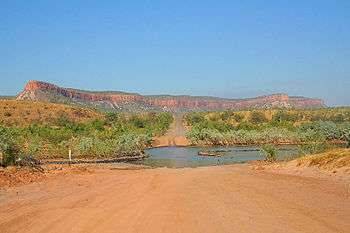Gibb River Road
The Gibb River Road is an unsealed track in the Kimberley region of Australia.
- This article is an itinerary.

Understand
Created in the 1960s as a cattle road, the Gibb River Road is a 650 km. - almost completely unsealed - track, cutting right through the Kimberley region of Australia, linking the Great Northern Highway on the east to Derby on the west.
The "road" is a shortcut of several hundred kilometers between points linked by the Great Northern Highway, which makes a large detour in the south. Driving the road is not an extreme adventure, but nevertheless requires caution and preparation, as it goes through very remote areas.
Drivers will be rewarded with magnificent scenery of the surrounding wilderness, as well as a sense of isolation and solitude.
Prepare
Of absolute necessity is a 4WD vehicle. If you plan to rent it, check the policy of the company from whom you rent it. Some companies require that you obtain prior permission with them to go on the Gibb River Road. Caravan is out of the question, and only very robust trailers may cope with the crossing. An experienced driver with a very robust 2WD may attempt the crossing, though it is definitively not recommended. The road goes through river beds and floodplains, it is simply not passable during the wet season (December to March), and even during the dry season check the conditions beforehand (for instance in Kununurra).
There is only one very small store at Mount Barnett, 350 km. after the eastern starting point on the road, so bring supplies with you. The whole crossing takes 3 to 5 days at a leisurely pace, but DO bring extra food and water in case you get stranded.
There is a grand total of 3 fuel supplies along the road : Mt Barnett, Imintji Roadhouse (diesel only) and Drysdale Station (58km north of Gibb River Road on Kalumburu Road). Needless to say, fuel prices are very high along the road, and as distances are great, so start the drive with a full tank, and be mindful of your fuel consumption.
There is little choice of roofed accommodation around the road. Apart of the large El Questro Station, a cattle station turned into a luxury facility at the eastern side of the road, there are a few lodges with available rooms for tourists to choose from. Mount Hart Wilderness Lodge , Drysdale River,Charnley River Station , Mount Elizabeth , Home Valley and Ellenbrae Station Phone (+61 8 9161 4325) all offer accommodation, but are sometimes a bit way off the road itself. If you plan to stay in one of those places, book ahead.
In any case, you can just pitch your tent alongside the road, but be careful as some parts are private property (though the private zones are clearly indicated).
Get in
The Gibb River Road crosses remote areas, and is itself not very easy to access.
Getting close to the road is however feasible. On the western side, OZJet flies between Derby and Perth.On the eastern side, AirNorth links Kununurra (60 km. from the eastern start point of the road) with Darwin. From either Derby or Kununurra, you can catch the 22 seater 4WD Gibb River Bus .
If you want to drive the road by yourself, you can also rent 4WD in Kununurra, but if you want to make a one-way drive, you will probably have to go as far as Broome (220 km to the east of Derby) to return the vehicle (and including an hefty one-way surplus), check with the rental company beforehand.
Kununurra is small, so the majority of 4WD rent a car companies simply do not have a branch there. If you want to use a national rental company, you will have to drive from Darwin to Broome, the total distance reaching a good 1850 km.
Drive
Driving is, needless to say, what you are expected to do on the Gibb River Road. However, there are a few short hikes through shadowy gorges that allow for some relaxing swims; just be careful and ask around as some might be inhabited by crocodiles, and do not swim if you are not sure the place is safe.
Stay safe
Crossing the Gibb River Road has become popular with tourists, but it still remains a trip that requires some caution. Do not get over alarmed, the crossing is done everyday (when the road is open, that is...), and simple precautions should avoid big trouble.
- Do not attempt the crossing in the wet season, or when signs advise you not to. If you get stranded, it will probably cost you a fortune and be horribly time consuming to get back to civilization.
- Although graders sometimes reduce the bumps, the track can easily become very badly corrugated, and parts are sandy or muddy in case of recent rain. Be very careful with your 4WD and do not over or under speed (corrugation is also very uncomfortable at low speeds). Read carefully Driving_in_Australia#Outback_driving, and familiarize yourself with the vehicle before entering the road.
- Bring extra food and extra water, just in case you do run into trouble.
- The area is prone to bush fires at the end of the dry season. Take care while camping.
- It is not a bad idea to warn the police post in Kununurra that you will take the road, with your estimated time of arrival on the other side in Derby. In that case, do not forget to confirm to the Derby police station that you have crossed the road.
Go next
From one way or another, you will finish your trip on the Gibb back on the Great Northern Highway.